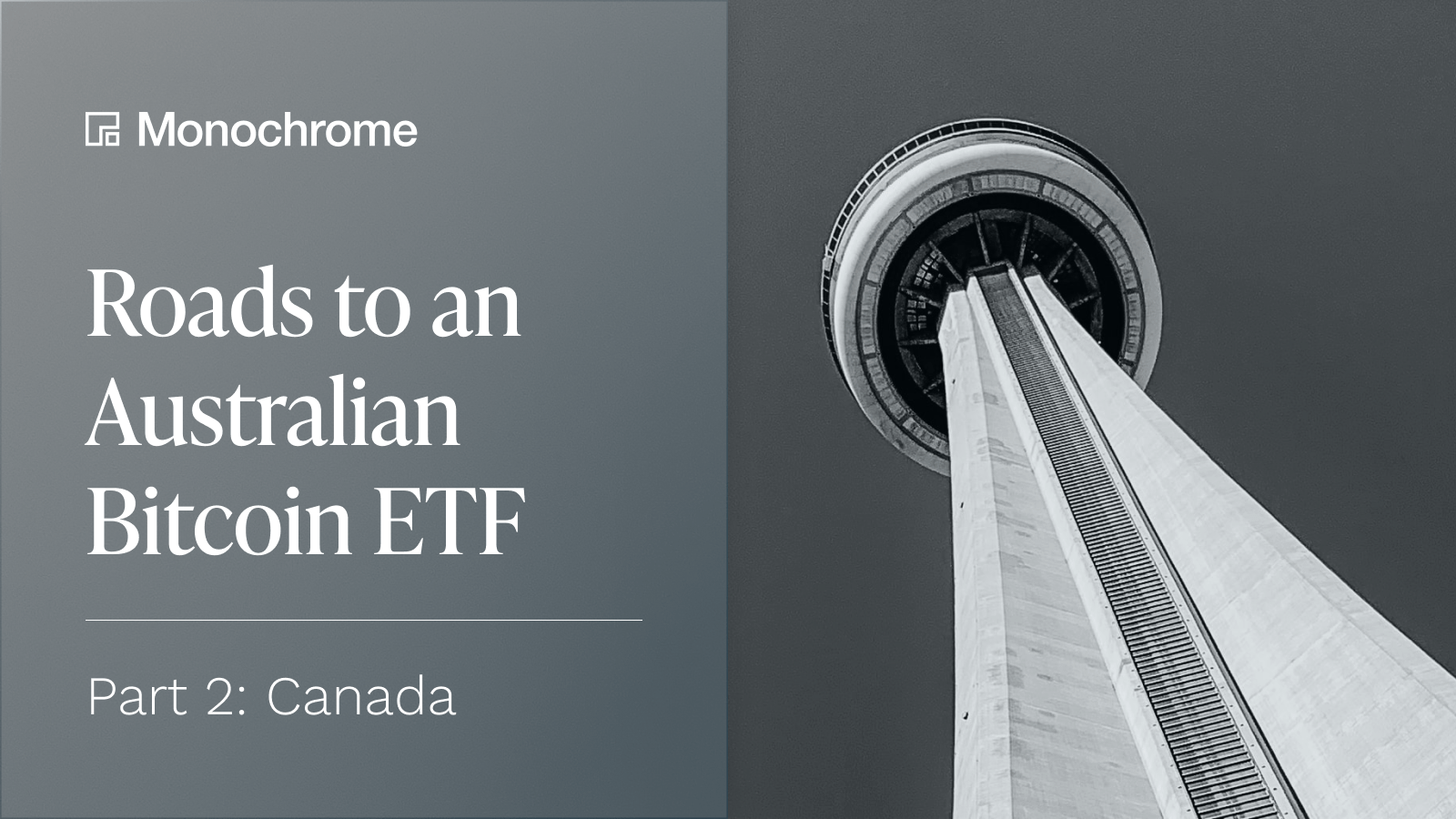Share

BRISBANE, March 2, 2022 – In the second of Monochrome’s multi-part series on Bitcoin’s investment market evolution, the team delves deeper into Canadian markets and the court cases that defined them, the world’s first spot Bitcoin ETF and why not all first-mover advantages are equal.
Canadian Bitcoin ETF Market Development
Though often lost in the shadow of its neighbour, the United States, Canada has been at the forefront of ETF related products ever since launching the world’s first ETF in 1990. The country also released the world’s first bond ETF in 2000, and importantly for those interested in digital assets, the first physically backed Bitcoin ETF.
As Australia gears up for its own Bitcoin ETF, investors may find value in understanding the process taken and history behind approvals and launches in Canada. Core to the Canadian story is a market-defining legal case that is often overlooked in its details.
Regulatory Steps to Canadian Bitcoin Products
Beginning in 2016, Canadian fund manager 3iQ Corp. began the process of approval for a publicly-traded Bitcoin fund with the Ontario Securities Commission (OSC). Without OSC approval, the fund would not be able to operate legally.
In early 2019, the fund submitted for approval a prospectus to regulators; however, this was denied by the OSC under the proviso of Bitcoin being a “novel asset currently in its nascent state”. The OSC viewed Bitcoin as an “illiquid asset” under NI 81-102, that it did not trade on established exchanges and that allowance of such a product was not in public interests, effectively stamping out the potential for any Bitcoin products in the domicile.
This position and associated rejection was challenged in a court appeal on the basis that the OSC had overstepped its role as a regulator in regards to each point of refutation.
A market-defining court case
During the court case, Judge Lawrence P Haber found regulators failed to provide sufficient evidence of Bitcoin as an “illiquid asset” under NI 81-102, as well as a misrepresentation of bitcoin liquidity. In the case summary it is noted that, “Much of their evidence was about crypto-assets, generally, rather than specifically addressing liquidity issues for bitcoin”, and that, “I give no weight to their evidence insofar as it relates to non-bitcoin crypto-asset trading, and non-registered exchange trading.”
Building on this, Judge Haber stated, “There is sufficient evidence of real volume and real trading in bitcoin on registered exchanges in large dollar size, both in absolute terms and compared to other markets for commodities and equities, which constitutes a liquid market.”
On the topic of trade on established exchanges, the panel found that global liquidity and the presence of regulatory oversight from the likes of the New York Department of Financial Services (via BitLicense) were sufficient to counter OSC claims.
Regarding the position of the Ontario Securities Commission rejecting the prospectus on account of the Canadian public’s interest, Judge Haber found that the OSC had overstepped a core tenet of Canada’s securities laws - that being that it is not the position of securities regulators to approve or disapprove the merits of the securities being offered to the public.
Of particular note are the sub-points noted under paragraph [69] in which Judge Haber comments, "I place considerable weight on the Fund’s investment parameters and restrictions that are set out in the Fund’s prospectus and confirmed by Mr. Cumby’s evidence: a. the Fund will invest in bitcoin, not in all crypto-assets, b. the Fund will be static and will pursue a buy and hold strategy and not an active trading strategy, and c. the Fund will only buy and sell bitcoin on regulated exchanges."
In October 2019, Judge Haber handed down a favourable ruling, ordering the Director’s decision to be set aside. As a result of this 3iQ was able to proceed with its prospectus application.
3iQ’s product offering, The Bitcoin Fund (QBTC), operates as a closed-end fund, in effect a variant form of Exchange Traded Product (ETP) rather than an Exchange Traded Fund (ETF). This differentiation of ETP vs ETF is fundamentally important for investors to consider and will be elaborated on in part 3 of this series.
Canadian Bitcoin finds its Purpose
With 3iQ’s landmark court decision, the floodgates to Canadian markets were opened, with the precedent set regarding Bitcoin, if not the entire asset class. As a result, the race to a Canadian Bitcoin ETF would begin.
The first across the line, both in Canada and in the world, was Purpose Investments on February 18th, 2021 with its Purpose Bitcoin ETF (BTCC) commencing trading on the Toronto Stock Exchange (TSX), reaching US$165 million in first day volume. Within the first week BTCC had US$48 million in assets under management (AUM).
In order to be listed, the BTCC fund is designated as an alternative mutual fund that falls under the category of National Instrument 81-102 Investment Funds (NI 81-102) and is established as a trust under the laws of the Province of Ontario. While being listed as an alternative mutual fund, the Fund is subject to restrictions and practices contained in Canadian securities legislation.
BTCC currently has CAD$1.6 billion under management as of the 25th of February, 2022, or 32329.777 BTC. Within the Purpose prospectus, it states that the fund has the ability to create more ETFs and investment products that are backed by bitcoin.
Bitcoin’s varying classification - is it a security or not?
This effective classification of Bitcoin as a security runs contrary to US and current Australian regulatory frameworks. The US Securities and Exchange Commission (SEC) has clarified its position under both the leadership of Jay Clayton and Gary Gensler. Both Gensler and Clayton refer to the Howey Test as the key decider for security classification.
Key to Bitcoin’s non-security classification in the US are comments made by then-Director of the SEC’s Division of Corporation Finance, William Hinman at the July 2018 Yahoo Finance All Markets Summit.
During his speech, Hinman pointed to varying levels of decentralisation in crypto projects as a major factor in security classification - “If the network on which the token or coin is to function is sufficiently decentralized – where purchasers would no longer reasonably expect a person or group to carry out essential managerial or entrepreneurial efforts – the assets may not represent an investment contract.
“Moreover, when the efforts of the third party are no longer a key factor for determining the enterprise’s success, material information asymmetries recede. As a network becomes truly decentralized, the ability to identify an issuer or promoter to make the requisite disclosures becomes difficult, and less meaningful.
“And so, when I look at Bitcoin today, I do not see a central third party whose efforts are a key determining factor in the enterprise. The network on which Bitcoin functions is operational and appears to have been decentralized for some time, perhaps from inception. Applying the disclosure regime of the federal securities laws to the offer and resale of Bitcoin would seem to add little value.”
Hinman would outline six non-exhaustive, illustrative steps that may be used to analyse if a digital asset or crypto project meets US security classification.
While neither Canadian nor US classifications of crypto-assets provide definitive direction for Australia, it may provide investors with useful context as Australia’s regulatory framework is built out.
Following ASIC’s 2021 Consultation Paper and subsequent Report (CP 343 and REP 705), Australian classification of Bitcoin and crypto-assets has gained some clarity. Amongst proposals was the creation of a separate cryptocurrency asset classification, differentiating them from existing market offerings. As of REP 705 the Australian Securities and Investment Commission (ASIC) does not consider that “collectively classifying crypto-assets as commodities is the most appropriate way to facilitate ETPs that provide exposure to crypto-assets”.
A pioneer returns to reap rewards
Following the successful court appeal to allow 3iQ’s breakthrough QBTC market offering, the firm would submit plans to launch an ETF offering to compete with Purpose’s BTCC.
Similar to the Purpose Bitcoin ETF, 3iQ faced OSC approval hurdles due to the classification of the fund. To resolve this, 3iQ required their offering to be listed as an alternative mutual fund the same way BTCC needed to be classified.
In April of 2021, 3iQ CoinShares Bitcoin ETF (BTCQ) began trading on the Toronto Stock Exchange (TSX). During September of 2021, 3iQ was able to amass CAD$1.2 billion (US$946 million ) assets under management (AUM) despite launching weeks after Purpose. During the same time, the Purpose fund had CAD$1.3 billion (US$1.02 billion) AUM.
While there is no explicit answer, brand recognition and capped expenses may be considered as contributing factors towards Canada’s competitive landscape. Though fees for both offerings are listed at 1.00%, total potential expenses differ, with BTCQ capped at 1.25% and BTCC capped at 1.5%.
| ETF | Fee (Annual) | Assets Under Management |
|---|---|---|
| Purpose Investments Bitcoin ETF (BTCC) | 1.00% | $1.6B |
| 3iQ CoinShares Bitcoin ETF (BTCQ) | 1.00% | $0.993B |
*All figures were updated on February 25th, 2022
When we draw comparison with the contemporaneously-launched U.S. Bitcoin Futures ETFs, the dissonance in first mover advantage between markets is made apparent. ProShares Bitcoin Strategy ETF (BITO) launched on October 19th, 2021 and was able to gain US$950 million assets under management (AUM) while Valkyrie Funds’ Bitcoin Strategy ETF (BTF) launched on October 22nd, 2021 with only US$36.54 million AUM. As evidenced by the table above, this was not seen in Canadian markets with their spot ETF offerings.
The consideration of fees as a deciding factor also falls to the wayside when one considers the introduction of VanEck Bitcoin Strategy (XBTF) in US markets - despite a vastly lower expense ratio (0.65% vs 0.95% of the leading two options, BITO and BTF) it holds a fraction of the Bitcoin futures market under management.
One should keep in mind that the Canadian Bitcoin Spot ETFs are fundamentally different products from the U.S. Bitcoin futures ETFs and that this may influence market performance characteristics.
The structure of an ETF, first mover advantage, fund brand recognition, and management fees are all variables that influence the success of Bitcoin ETFs; however, as illustrated above there is no blanket rule that can be used.
What is a Bitcoin Spot ETF?
In part 1, Monochrome provided an overview of futures-based Bitcoin ETFs, as well as the structural limitations associated with them. As a result of these factors, many investors and allocators may not consider such a structure to be suitable for their portfolios - instead looking to opt for the spot form.
A spot Bitcoin ETF is a physically settled Bitcoin ETF. The purpose of a spot Bitcoin ETF is to allow indirect Bitcoin exposure for institutional and retail investors through a regulated financial product without the need to hold bitcoin themselves.
Benefits include:
- Easier for institutions and retail investors to buy from their current brokerage accounts.
- Easier to determine the net asset value of a spot Bitcoin ETF. Every share of the ETF will represent a portion of Bitcoin held by the fund.
- Bitcoin exposure through a regulated product.
- Investors do not need to store or manage bitcoin.
Considering the above, physically settled Bitcoin ETFs offer perhaps the most effective value proposition parallel to self-custodied bitcoin investment whilst operating inside a regulated framework.
In the absence of such a product, many markets have seen the proliferation of “ETF-like” offerings aiming to mimic the characteristics of a physically-settled Bitcoin ETF. Such products carry over intricacies and risks that may alter an investment thesis in unanticipated ways.
Alternate developments
In part 3 of the series, Monochrome will turn to Europe to examine the varied adoption of Bitcoin as an investment asset. Included in this will be a focus on differing Exchange Traded Product (ETP) frameworks and the intricacies these introduce to a Bitcoin-specific product offering, and thus the manner in which professionals may consider them from an investment perspective.
The content, presentations and discussion topics covered in this material are intended for licensed financial advisers and institutional clients only and are not intended for use by retail clients. No representation, warranty or undertaking is given or made in relation to the accuracy or completeness of the information presented. Except for any liability which cannot be excluded, Monochrome, its directors, officers, employees and agents disclaim all liability for any error or inaccuracy in this material or any loss or damage suffered by any person as a consequence of relying upon it. Monochrome advises that the views expressed in this material are not necessarily those of Monochrome or of any organisation Monochrome is associated with. Monochrome does not purport to provide legal or other expert advice in this material and if any such advice is required, you should obtain the services of a suitably qualified professional.
Related Articles

Monochrome Partners with Galaxy Digital for Total Bitcoin Wealth Management
Monochrome Capital, a related entity of the investment manager of the Monochrome Bitcoin ETF (IBTC), today announced a strategic partnership with Galaxy Digital to deliver comprehensive Bitcoin wealth management solutions for institutional clients.

IBTC Integrated into Bitcoin-Backed Mortgages for Qualifying High-Net-Worth Investors
The Monochrome Bitcoin ETF (IBTC) has been incorporated into a Top 4 Australian bank’s residential mortgage lending framework. IBTC is now recognised alongside traditional assets such as unencumbered property and income streams when assessing high-net-worth (HNW) investors for home loans. This development connects regulated Bitcoin ETFs with private banking services, enabling Bitcoin holders to access property financing without liquidating their exposure.

